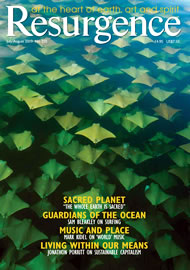We can relate to our planet Earth in two ways: either we can act as tourists and look at the Earth as a resource of goods and services for our use, pleasure and enjoyment, or we can act as Earth Pilgrims and treat the planet with reverence and gratitude. Tourists value the Earth and all her natural riches only in terms of usefulness to themselves. Pilgrims perceive the planet as sacred and recognise the intrinsic value of all life. The living Earth is good in itself with all its grace and beauty.
Tourists find gratification in the consumption of Nature’s gifts. Pilgrims find enchantment in the conservation of Nature’s bounty. The abundant waters of the oceans, the vibrancy of forests, the communities of dancing birds, the tranquillity of valleys and the resilience of magnificent mountains bring a sense of joy, awe and wonder to the hearts of pilgrims. For them, ‘god’ is Nature, and Nature is their god. Nature is their teacher, their guru and their guide. Sometimes they call her Gaia, the Earth Goddess or simply Mother Nature.
Indigenous people of the world lived and behaved as pilgrims. The Earth was their temple, their church and their mosque. They went into the wild for their vision quest. They sat under the trees for their prayers and meditation. They did not look up to the sky to find heaven: their heaven was here on Earth.
St Francis was a pilgrim of this sacred planet. Wolves, birds and all other creatures were his kith and kin; the sun and the fire were his brothers; the moon, the stars, the wind and water were his sisters.
For Hindus, god is not a person sitting in paradise. For them all life is imbued with the divine. Everything from a blade of grass to the high Himalayas is permeated through and through with the sacred spirit. Hindus consider themselves to be pilgrims on planet Earth.
In all religious traditions there are some special sacred sites; they are like the seven chakras or the acupuncture points of the human body. Pilgrims make journeys to these sites: the holy mounts of Kailash and Athos, the holy rivers of Ganges and Yangtze, the Camino de Santiago de Compostela and the Isle of Iona are such sacred places. It is useful to make outer journeys in order to make inner journeys but the significant realisation of a pilgrimage is in the consciousness that the whole of the Earth is sacred.
Of course, every one of us can discover a particular site which resonates with our spirit, where we can go and be in solitude and find ourselves; it may be a particular tree, or hill, or expanse of seashore. Such special sacred sites are significant symbols: just as a mantra is a sound that connects us with the cosmic consciousness, similarly a particular grove, cave or valley can be a point to connect us with the Earth.
The sacred Earth is a gracious host to all pilgrims, but are we prepared to be gracious pilgrim guests rather than mere tourists? This question is explored from many different angles in the special feature on our Sacred Planet in this issue of Resurgence. I hope you enjoy reading these contributions, which remind us of our deep connection with the Earth.
SATISH KUMAR






